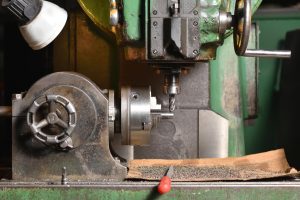Learn the Basics of Machining Tools and Techniques

General machining is like an exciting puzzle where you shape and form materials into useful products. This process involves a variety of tools and machines that cut, shape, and finish materials, often metals. Whether you’re creating parts for a machine or crafting something new, understanding the basics of machining is essential.
Tools and equipment used in machining range from simple hand tools to more complex machines like lathes and milling machines. These tools help shape materials precisely, giving birth to well-crafted parts and products. Learning to operate these machines can be fun and rewarding, especially when you see your creations take shape.
Machining skills are valuable in many industries, from automotive to manufacturing. Knowing the right techniques not only helps in crafting accurate pieces but also ensures safety in the workplace. As you dive into machining, you’ll discover a mix of challenges and triumphs, all part of creating quality products. Whether you’re a beginner or have some experience, there’s always something new to learn in the world of machining.
Introduction to General Machining Tools and Equipment
In machining, having the right tools is like having a superhero toolkit. They make crafting and shaping materials easy and precise. Each tool serves a specific purpose, helping you achieve the perfect product.
Some of the basic tools and machines in general machining include:
1. Lathes: These machines spin materials, allowing you to cut and shape them into round items like brackets and wheels. They are great for creating symmetrical pieces.
2. Milling Machines: These machines work with stationary materials to cut and shape complex details. Milling machines are perfect for creating intricate designs and patterns.
3. Drilling Machines: As the name suggests, these machines are used to make holes. They are useful in creating openings for screws or connecting two parts.
4. Grinders: These machines help polish and smooth surfaces. They are vital for finishing touches that require precise surface smoothness.
5. Saws: Used to cut materials into specific shapes and sizes. Saws can handle various materials, from metals to plastics.
6. Hand Tools: These include hammers, chisels, and files. They are essential for detailed finishing and adjustments where machines cannot reach.
Understanding these tools lets you choose the right one for your project. Each tool is important and plays a role in helping you achieve the desired outcome in your machining work.
Basic Machining Techniques Everyone Should Know
Mastering basic machining techniques is like learning the alphabet in crafting products. Knowing these skills makes the creation process smooth and efficient. Here are some important techniques you should be familiar with:
1. Turning: This involves rotating a workpiece against a cutting tool. It’s a fundamental method for creating cylindrical shapes, typically done on a lathe.
2. Facing: A technique to smooth the end of a piece. It involves moving the cutting tool across the face of the rotating workpiece, removing layers until it’s flat or at the desired angle.
3. Drilling: Used to create holes in materials. Knowing how to properly align and set up a drill ensures accurate and clean holes.
4. Milling: This technique uses cutting tools to remove material and shape surfaces. It’s essential for crafting both flat and angled surfaces.
5. Cutting: A broad technique using saws and other tools to slice materials into specific shapes and sizes. It requires a steady hand and exact measure to achieve the right cuts.
6. Polishing: Giving a product its final smoothness and shine. This technique uses grinders and sanders to refine the surface.
Understanding and practicing these techniques helps you improve your machining skills. These basics are the building blocks for creating everything from small components to large, complex products. Whether you’re just starting or have some experience, these techniques will guide you in your projects.
Common Challenges in Machining and How to Overcome Them
Machining can sometimes feel like a puzzle with missing pieces, where things don’t always go as planned. Facing these challenges is part of the learning process. Here are some common problems and solutions to keep your machining journey smooth.
1. Tool Wear and Tear: Constant use can wear out tools, leading to poor performance. Regular maintenance and timely replacement of worn tools keep operations running efficiently.
2. Material Defects: Materials sometimes come with imperfections that affect the machining process. Inspecting materials beforehand helps identify potential issues, allowing adjustments to be made early.
3. Inaccurate Measurements: Precision is key in machining. Double-check all measurements before starting to ensure the final product meets specifications.
4. Chatter: Excessive vibration during cutting can ruin the finish. Reducing spindle speed or using sharper tools can minimize vibration and improve results.
5. Overheating: Machines and materials can overheat, affecting quality. Using proper cooling methods and allowing machines to rest can help manage temperature.
By anticipating these challenges and preparing solutions, you can ensure consistent quality in machining tasks. Understanding these common issues and how to overcome them boosts both confidence and skill.
Safety Tips and Best Practices for Beginners in Machining
Safety is paramount when working with machinery. Knowing how to protect yourself and operate machines correctly makes machining safer and more enjoyable. Here are some tips to keep in mind:
1. Wear Appropriate Gear: Safety goggles, gloves, and appropriate clothing protect against hazards. Avoid loose-fitting clothes that might get caught in machines.
2. Keep Work Area Clean: A tidy workspace prevents accidents. Regularly clean machines and the surrounding area to avoid slips and equipment malfunctions.
3. Understand Equipment: Familiarize yourself with the machines you are using. Read manuals and receive training to operate machines safely.
4. Use Guards: Machine guards are there for protection. Ensure all safety guards are in place before starting any work.
5. Never Rush: Take your time with each task to avoid mistakes and accidents. Rushing increases the risk of errors and injuries.
By following these safety tips and best practices, you can minimize the risks involved in machining. Safety should always come first in every project.
Conclusion
Machining is a valuable skill that opens up a world of possibilities in creating precise and functional products. Whether you are crafting elements for safety measures, display cases, or building components for creative projects, understanding machining improves your work’s quality and satisfaction. From choosing the right tools to mastering basic techniques and tackling challenges, each step enhances your ability to produce high-quality results.
Learning machining is a journey full of creativity and problem-solving. Each project adds to your experience, making you more adept at facing new challenges. Keeping safety in mind ensures that your learning experience is both rewarding and injury-free. As you delve deeper into the world of machining, you’ll find countless opportunities to apply these skills in innovative ways.
Eager to put your machining skills to the test? At Canus Plastics Inc., we provide the resources and expertise to help you succeed in all your plastic needs. Whether crafting intricate marketing displays or building durable safety equipment, Canus Plastics Inc. is your partner in creation. Start your next project with us and explore the potential of Ottawa plastic machining today!

